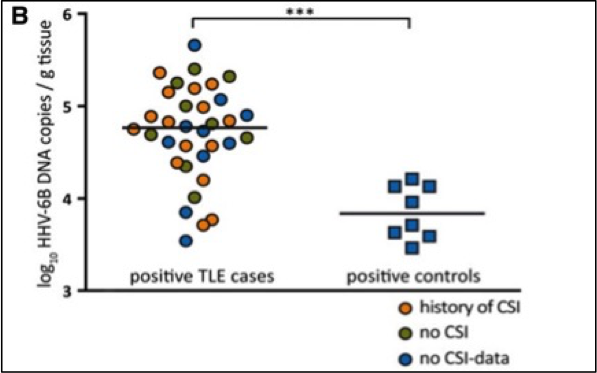Investigators at the University of Bonn Medical Center in Germany have screened 346 fresh-frozen brain tissue resections from temporal lobe epilepsy (TLE) patients for all nine herpesviruses as well as for RNA viruses including Paramyxovirinae, Phleboviruses, Enteroviruses, and Flavivirus, using qPCR. HHV-6B was the only virus identified. HHV-6B was also the only virus found in autopsy controls, but the viral load was significantly lower in controls relative to epilepsy patients (p>0.001). Furthermore, the group found that epilepsy patients with a history of seizures or encephalitis had a higher prevalence of HHV-6B DNA (15.0%) found in the brain tissue compared to controls (6.3%).
The Bonn group also conducted a meta-analysis of past studies of resected brain tissue of patients with mesial temporal lobe epilepsy. They looked at 8 studies with 524 patients and found that the prevalence of HHV-6B viral DNA was higher in patients with a history febrile seizures (25%) and encephalitis (28%) compared to patients with other forms of encephalitis or autopsy controls (10%).
Although the Bonn group excluded patients with chronic neurological disease in choosing autopsy tissues as controls, the autopsy specimens were not age-matched and were not considered healthy. Finding an appropriate control group for comparison is difficult for because HHV-6 reactivation has been implicated in many conditions including heart disease and brain tumors, and reactivates in the elderly as immune systems fail.
The authors conclude that, given the higher viral load in patients with TLE, and the fact that the prevalence is higher in patients with a history of inflammatory disease, further investigation is warranted.
Several smaller studies have found a higher prevalence of HHV-6B in patients with a history of inflammatory disease. For example, Steve Jacobson’s group at NINDS found that 11/18 or 69% of fresh epilepsy resection tissues were positive for HHV-6B DNA (Fotheringham 2007). And a new study out from a Chinese group found 39% of 46 MTLE resections positive for HHV-6B, using both nested and qPCR, and an even higher prevalence (57%) in those positive for the ApoE4 allele (Huang 2015).
Both HHV-6B and HHV-7 cause febrile seizures, and HHV-6B is thought to cause approximately one-third of febrile status epilepticus cases (Epstein 2012). A significant number of patients who develop HHV-6B encephalitis go on to develop epilepsy within a few years, but it is not known if HHV-6B induced febrile seizures might increase the risk of developing epilepsy.
For more information, read the full paper.

Figure 3B
